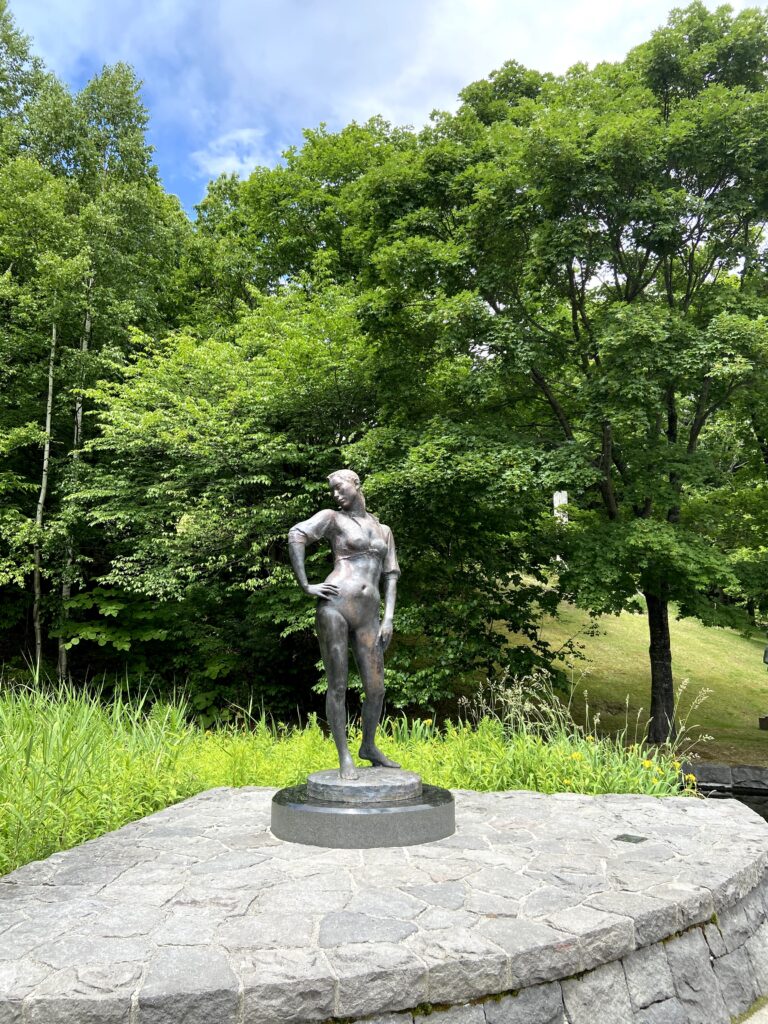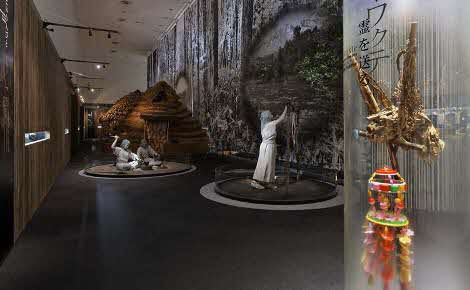This literary museum features Junichi Watanabe, a Naoki Prize-winning writer who hailed from Hokkaido. Adjacent to nature-rich Nakajima Park, the building was designed by the architect Tadao Ando. The museum introduces visitors to his literary world through his handwritten manuscripts and various exhibits that trace his life and career. The facility has a library with his entire works and his hobby books, a relaxing café with an air of openness, and a basement concert hall, reflecting Junichi’s concept of making it not a literary museum with a solemn atmosphere, but an innovative and spirited literary museum frequented by visitors.
施設
Asahikawa City Museum
This museum showcases the history, culture, and nature of northern Hokkaido, including Asahikawa City, under the theme of “encountering the history and culture of the indigenous Ainu people”.
The first-floor exhibition room features that history and culture, whereas the first basement floor showcases animals, plants, and people surviving the extreme cold of winter. These rooms display large numbers of Ainu and various other materials with easy-to-understand explanations.
The museum also displays a reconstructed traditional Ainu dwelling and barracks for tondenhei farmer-soldiers, giving a glimpse into people’s everyday lives in those days.
Kitami City Rubeshibe Muka Ekitei
This facility originally opened on January 28, 1920 to promote land reclamation in the Muka Wilderness. Back then, it played crucial roles as a counselling center for settlers in the Onneyu, Yamato, Takinoyu, and other districts of today’s Rubeshibe Town in Kitami City, as a rest place and lodgings for travelers, and as a relay station for horses. However, the facility closed in 1936 and was transferred free of charge to Junichiro Sano, who had served as the facility’s first manager. It was used as a house until 1970. The Kitami City Government (former Rubeshibe Town Government) restored the building to its original state as a valuable cultural property and opened it to the public as the Development History Museum (Kaitaku Shiryokan). In fiscal 2021, the city government renovated the building and renamed it the Kitami City Rubeshibe Muka Ekitei, displaying items that showcase the original roles of the facility, people’s daily lives, and more.
Hokkaido Sakamoto Ryoma Museum
Why does Hokkaido have a museum featuring the legendary samurai Ryoma Sakamoto? This facility helps visitors learn about his dreams for Hokkaido and about the close connections between his family and Hokkaido. It displays letters written by Ryoma and 50 swords, including his favorites. Also exhibited are goods closely related to men of noble ideals in the last days of the Tokugawa shogunate.
Fukuhara Memorial Museum
This museum features the collection of Mr. Jihei Fukuhara, the founder of the Fukuhara Supermarket chain which operates in the Tokachi and Kushiro regions of Hokkaido. The wide variety of artworks on display include those by artists representative of Japan and by those closely associated with the Tokachi region.
Museum of Soils and Tractors of the World
This museum was established on July 1, 1992 to promote the abiding principles of its founder, Sugano Farm Machinery MFG., Co., Ltd., that remain unchanged since the company’s founding and to promote the significance of agriculture as well as the importance of the relationship between soil and humans. The museum also aims to serve as a forum for contemplation on the importance of food and the natural environment surrounding soil. Displaying farm equipment used by those who reclaimed the land of Hokkaido and soil monoliths (specimens) collected in Japan and elsewhere, the facility enables visitors to learn about soil characteristics and hardships involved in land and soil improvement. Displayed in the Tractor Museum annex are numerous tractors dating back to the dawn of agricultural mechanization.
Hamatonbetsu Town Historical Museum
This museum opened in 1996, repurposed from a brick building constructed in 1930. It displays local materials and panels explaining the nature, history, and culture of Hamatonbetsu Town. It also holds lecture meetings, special exhibitions, and other events.
Sapporo Art Museum
Sapporo Art Museum opened in 1990 in the Sapporo Art Park cultural complex nestled in the verdant hills of southern Sapporo. The museum’s collections include works by artists closely related to Sapporo and Hokkaido, and modern artworks from Japan and elsewhere. The museum hosts special exhibitions of varied content and engages in art-related research.
Other facilities at Sapporo Art Park
Sapporo Sculpture Garden



A sculpture garden spreading across a 7.5-hectare site
The Sapporo Sculpture Garden allows visitors to stroll through a refreshing forest while appreciating 74 sculptures crafted by 64 sculptors, including works by leading Japanese and other contemporary sculptors, works by the Norwegian sculptor Gustav Vigeland, and works donated by Sapporo’s sister cities. Many of the sculptures were crafted for the garden after the sculptors visited the site to check the topography and surrounding conditions as well as the climate of Sapporo.
Sato Churyo Children’s Atelier


Hands-on gallery under the theme of the World of Churyo Sato and Children
Churyo Sato was a leading Japanese sculptor who was born in Miyagi Prefecture and spent his impressionable years from age 13 to age 20 in Sapporo. This facility displays heartwarming sculptures and sketches by the artist, who is closely associated with Sapporo, that use families and children as motifs. The workshop room allows visitors—whether they’re alone or with their family—to engage in creative activities.
Hokuto City Hometown Museum
Hokuto City, on the Tsugaru Strait at the base of the Oshima Peninsula, a gateway to Hokkaido, has been where the southern and northern cultures meet since the days of yore. This museum features local history from the Paleolithic and Jomon periods to the Epi-Jomon and Satsumon periods, as well as from the Ainu culture period to the medieval, modern, and present-day eras.
Numata Fossil Museum
This museum aims to enable visitors to not only view but also experience fossils. The workshop room offers a mini-excavation program to excavate small fossils or crystals from lumps of earth. Items shown in the exhibition room include reconstructed skeletons of extinct creatures whose fossils were discovered in Numata Town. These include a gigantic, 12-meter-long plesiosaur—something that’s sure to thrill dinosaur fans.




-scaled.jpg)





.jpg)